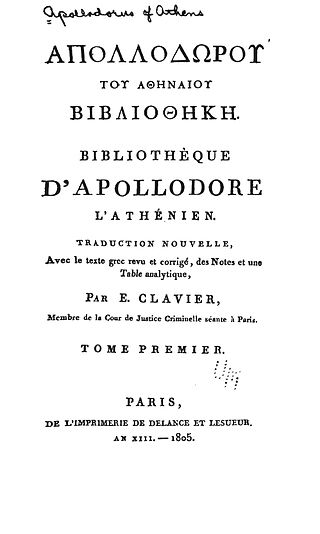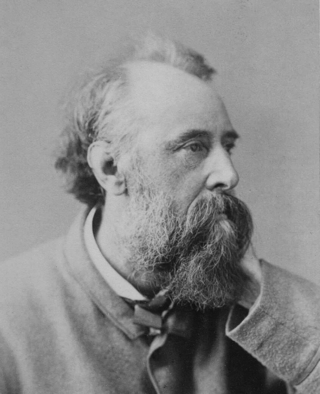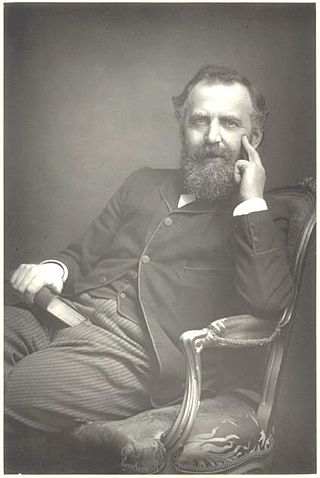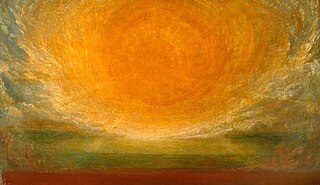
Athena or Athene, often given the epithet Pallas, is an ancient Greek goddess associated with wisdom, warfare, and handicraft who was later syncretized with the Roman goddess Minerva. Athena was regarded as the patron and protectress of various cities across Greece, particularly the city of Athens, from which she most likely received her name. The Parthenon on the Acropolis of Athens is dedicated to her. Her major symbols include owls, olive trees, snakes, and the Gorgoneion. In art, she is generally depicted wearing a helmet and holding a spear.

Aegeus was one of the kings of Athens in Greek mythology, who gave his name to the Aegean Sea, was the father of Theseus, and founded Athenian institutions.

In Greek mythology, Daedalus was a skillful architect and craftsman, seen as a symbol of wisdom, knowledge and power. He is the father of Icarus, the uncle of Perdix, and possibly also the father of Iapyx. Among his most famous creations are the wooden cow for Pasiphaë, the Labyrinth for King Minos of Crete which imprisoned the Minotaur, and wings that he and his son Icarus used to attempt to escape Crete. It was during this escape that Icarus did not heed his father's warnings and flew too close to the sun; the wax holding his wings together melted and Icarus fell to his death.

In Greek mythology, the Minotaur, also known as Asterion, is a mythical creature portrayed during classical antiquity with the head and tail of a bull and the body of a man or, as described by Roman poet Ovid, a being "part man and part bull". He dwelt at the center of the Labyrinth, which was an elaborate maze-like construction designed by the architect Daedalus and his son Icarus, upon command of King Minos of Crete. According to tradition, every nine years the people of Athens were compelled by King Minos to choose fourteen young noble citizens to be offered as sacrificial victims to the Minotaur in retribution for the death of Minos's son Androgeos. The Minotaur was eventually slain by the Athenian hero Theseus, who managed to navigate the labyrinth with the help of a thread offered to him by the King's daughter, Ariadne.

In Greek mythology, Minos was a king of Crete, son of Zeus and Europa. Every nine years, he made King Aegeus pick seven young boys and seven young girls to be sent to Daedalus's creation, the labyrinth, to be eaten by the Minotaur. After his death, King Minos became a judge of the dead in the underworld alongside Rhadamanthus and Aeacus.

In Greek mythology, Pasiphaë was a queen of Crete, and was often referred to as goddess of witchcraft and sorcery. The daughter of Helios and the Oceanid nymph Perse, Pasiphaë is notable as the mother of the Minotaur. Her husband, Minos, failed to sacrifice the Cretan Bull to Poseidon as he had promised. Poseidon then cursed Pasiphaë to fall in love with the bull. Athenian inventor Daedalus built a hollow cow for her to hide in so she could mate with the bull, which resulted in her conceiving the Minotaur.

Theseus was a divine hero in Greek mythology, famous for slaying the Minotaur. The myths surrounding Theseus, his journeys, exploits, and friends, have provided material for storytelling throughout the ages.

In Greek mythology, Europa was a Phoenician princess from Tyre and the mother of King Minos of Crete. The continent of Europe is named after her. The story of her abduction by Zeus in the form of a bull was a Cretan story; as classicist Károly Kerényi points out, "most of the love-stories concerning Zeus originated from more ancient tales describing his marriages with goddesses. This can especially be said of the story of Europa."

In Greek mythology, Ariadne was a Cretan princess, the daughter of King Minos of Crete. There are different variations of Ariadne's myth, but she is known for helping Theseus escape from the Minotaur and being abandoned by him on the island of Naxos. There, Dionysus saw Ariadne sleeping, fell in love with her, and later married her. Many versions of the myth recount Dionysus throwing Ariadne's jeweled crown into the sky to create a constellation, the Corona Borealis.

In Greek mythology, Icarus was the son of the master craftsman Daedalus, the architect of the labyrinth of Crete. After Theseus, king of Athens and enemy of Minos, escaped from the labyrinth, King Minos suspected that Icarus and Daedalus had revealed the labyrinth's secrets and imprisoned them—either in a large tower overlooking the ocean or in the labyrinth itself, depending upon the account. Icarus and Daedalus escaped using wings Daedalus constructed from birds’ molted feathers, threads from blankets, the leather straps from their sandals, and beeswax. Before escaping, Daedalus warned Icarus not to fly too low or the water would soak the feathers and not to fly too close to the sun or the heat would melt the wax. Icarus ignored Daedalus's instructions not to fly too close to the sun, causing the beeswax in his wings to melt. Icarus fell from the sky, plunged into the sea, and drowned. The myth gave rise to the idiom, "fly too close to the sun." In some versions of the tale, Daedalus and Icarus escape by ship.

In Greek mythology, the Cretan Bull was the bull Pasiphaë fell in love with, giving birth to the Minotaur.

The Bibliotheca, is a compendium of Greek myths and heroic legends, genealogical tables and histories arranged in three books, generally dated to the first or second century AD. The work is commonly described as having been written by Apollodorus, a result of its false attribution to the 2nd-century BC scholar Apollodorus of Athens.

George Frederic Watts was a British painter and sculptor associated with the Symbolist movement. Watts became famous in his lifetime for his allegorical works, such as Hope and Love and Life. These paintings were intended to form part of an epic symbolic cycle called the "House of Life", in which the emotions and aspirations of life would all be represented in a universal symbolic language.
"The House of Asterion" is a short story by Argentine writer Jorge Luis Borges. The story was first published in 1947 in the literary magazine Los Anales de Buenos Aires and republished in Borges's short story collection The Aleph in 1949. It is based on the Greek myth of Theseus and the Minotaur and is told from the perspective of Asterion, the Minotaur.
The Minotaur is a mythological monster, half-man and half-bull.

"The Maiden Tribute of Modern Babylon" was a series of newspaper articles on child prostitution that appeared in The Pall Mall Gazette in July 1885. Written by the paper's crusading editor W. T. Stead, the series was a tour de force of Victorian journalism. With sensational crossheads, such as "The Violation of Virgins" and "Strapping Girls Down", the Maiden Tribute achieved, as a consequence, the implementation of the Criminal Law Amendment Act of 1885, which raised the age of consent for girls from 13 to 16.

Mammon, originally exhibited as Mammon. Dedicated to his Worshippers, is an 1885 oil painting by English artist George Frederic Watts, currently in Tate Britain. One of a number of paintings by Watts in this period on the theme of the corrupting influence of wealth, Mammon shows a scene from Edmund Spenser's The Faerie Queene in which Mammon, the embodiment of greed, crushes the weak through his indifference to their plight. This reflected Watts's belief that wealth was taking the place of religion in modern society, and that this worship of riches was leading to social deterioration. The painting was one of a group of works Watts donated to the South Kensington Museum in late 1886, and in 1897 it was one of 17 Watts paintings transferred to the newly created Tate Gallery. Although rarely exhibited outside the Tate Gallery, the popularity of reproductions made Mammon one of Watts's better known paintings.

After the Deluge, also known as The Forty-First Day, is a Symbolist oil painting by English artist George Frederic Watts, first exhibited as The Sun in an incomplete form in 1886, and completed in 1891. It shows a scene from the story of Noah's Flood, in which after 40 days of rain Noah opens the window of his Ark to see that the rain has stopped. Watts felt that modern society was in decline owing to a lack of moral values, and he often painted works on the topic of the Flood and its cleansing of the unworthy from the world. The painting takes the form of a stylized seascape, dominated by a bright sunburst breaking through clouds. Although this was a theme Watts had depicted previously in The Genius of Greek Poetry in 1878, After the Deluge took a radically different approach. With this painting he intended to evoke God in the act of creation, but avoid depicting the Creator directly.
In Greek mythology, Asterion or Asterius was a King of Crete and the foster-father of Minos.
In Greek mythology, Androgeus or Androgeos was a Cretan prince as the son of King Minos.
















